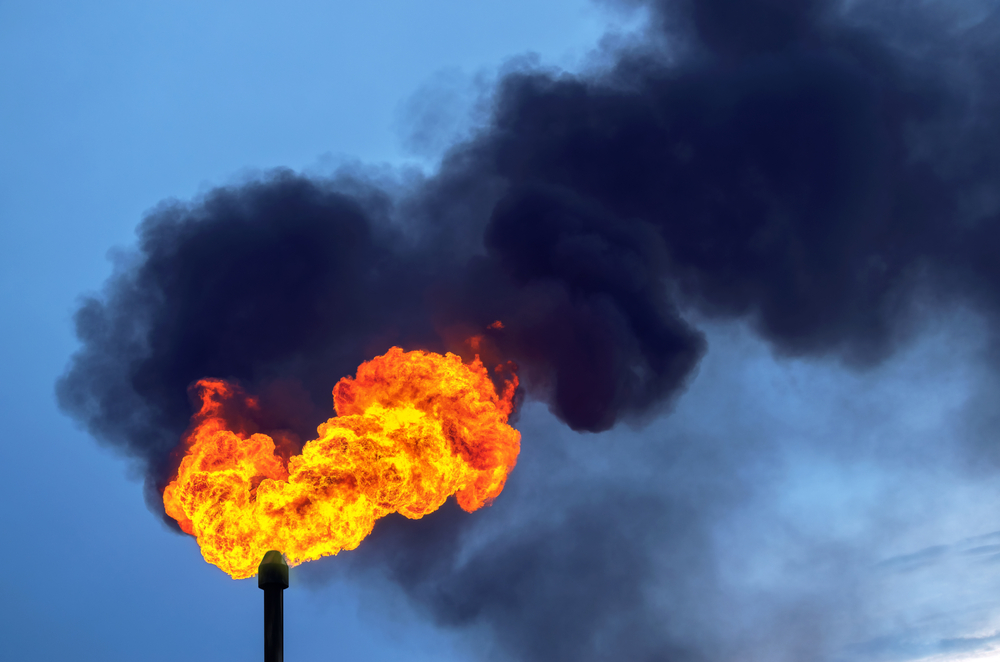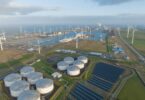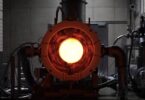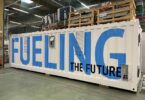While hiking in the Colorado Rockies in 2018 two high school friends in their 30s – one an heir to an oil and gas company who had his consciousness raised about climate change while at university, the other a graduate of MIT and Stanford with expertise in finance, computer science and AI – came up with a business plan. Their novel idea? Recuperate the wasted gas that oil and gas producers burn each year – contributing to global warming- and use that energy to mine cryptocurrency, power AI’s huge energy needs, and offer cheaper, cleaner Cloud services to customers.
Fast forward five years and Crusoe Energy Systems, the company Cully Cavness and Chase Lochmiller co-founded, counts oil producers ExxonMobil and Devon Energy as well as AI startups and research organizations among its customers. The Colorado-based startup has raised over $500 million, giving the company a valuation of $1.75 billion in its last funding round. Top Silicon Valley venture firms, the sovereign wealth funds of Oman and Abu Dhabi, as well Japanese trading house Mitsui & Co. are among its backers.
Crusoe’s Digital Flare Mitigation (DFM) technology is deployed directly to oil well sites to convert stranded gas, which would otherwise be wasted and flared, into electricity to power modular data centers housed in 40-foot shipping containers. “Moving gas and power is more difficult than moving data so we bring the equipment necessary to process intensive computing workloads to the source,” says Lochmiller. The scale-up’s data centers support high-performance computing including cryptocurrency transaction processing (mining) as well as CrusoeCloud, a cloud computing platform for computational biology, artificial intelligence and 3D rendering.
The draw for oil producers is that they generate some revenue from gas that would otherwise go to waste while reducing their environmental footprint. The advantage for companies that need a lot of processing power, such as AI startups, is that they can buy greener energy at a steep discount.
Crusoe says its deployed fleet of flare-eliminating data centers have a capacity to reduce CO2-equivalent emissions estimated at 650,000 metric tons per year, comparable to removing approximately 140,000 cars from the road.
“We are proud of the energy story and the way we have been able to make this all work,” says Lochmiller.
Cruscoe Energy’s innovation is an example of how young companies can work with legacy players to abate climate change and help solve the U.N.’s Sustainable Development Goals.
Up In Smoke
Natural gas flaring is the controlled combustion of volatile hydrocarbons (hydrocarbons in a gas phase) that are released as a byproduct of oil production. The practice originated in the 1800s as a safety precaution to avoid the accumulation of combustible gasses at ground level where sparks could create a fire or explosion. Flaring’s use steadily expanded globally wherever oil is produced in places without sufficient or timely natural gas transportation infrastructure such as pipelines, gas processing plants, compressor stations and related systems. Because the value of natural gas is minimal compared to that of oil, if the oil company doesn’t have access to a pipeline or if the gas volumes are too small to justify infrastructure investment, then it is often cheapest and easiest for the oil producer to burn its associated gas in a flare.
According to the World Bank’s Global Gas Flaring Tracker Report, 144 billion cubic meters of natural gas was flared in 2021. That much gas could have generated 1,800 Terawatt hours (TWh) of energy – or almost two-thirds of the European Union’s net domestic electricity generation. Instead, it was burned away with no discernible value.
The Global Impact of Flaring
But the biggest problem with flaring is actually the methane that is not fully combusted. A recent study led by scientists at the University of Michigan and published in the journal Science found that in the U.S., flares only effectively destroyed 91.1% of methane, with the rest escaping into the atmosphere. This finding, based on surveys of more than 300 flares across the United States, indicates that the oil industry is producing nearly five times more methane emissions from flaring than prior EPA estimates, which have long-assumed a 98% combustion efficiency for flares. over a 20-year timeframe, methane is over 80x more potent than carbon dioxide as a greenhouse gas, meaning the escaped methane significantly contributes to climate change, especially over the short-term period most relevant to mid-century climate goals and pledges.
The good news is that “if we fix flaring issues, the payoff is huge: the equivalent of removing three million cars from the roads,” according to a University of Michigan article.
A Practical Alternative
Crusoe’s DFM technology offers oil producers an economic and operationally practical alternative to natural gas flaring. Through a process called stoichiometric combustion Crusoe says its DFM technology achieves a combustion efficiency of 99.9% (versus an average of 91.1% for flares), reducing methane emissions approximately 99% and carbon dioxide equivalent emissions by up to 68.6%.
Kraken Resources, a private equity-backed exploration and production oil and gas company formed in 2012 to focus on drilling and development opportunities in the Williston Basin of Montana and North Dakota, primarily in the prolific Bakken formation, is one of Crusoe’s customers. Kraken says it works with its midstream partners to gather and process as much of its natural gas production as possible, but a certain amount is stranded. The company says it recognized in 2018-19 the need for mobile, onsite technologies and started exploring and experimenting with multiple ways to use the stranded gas, including onsite power generation for well use, technology to capture and bring to market the heavier components of the gas stream, and Crusoe’s solution. After a successful initial pilot test in Montana with Crusoe, Kraken subsequently piloted solutions with other providers that offered ways to use the stranded gas to mine cryptocurrency. “Crusoe stood out in their understanding of and dedication to the technology necessary to keep the equipment running and demonstrated intelligence and integrity in their approach,” Kraken Resources President and CEO Bruce Larsen said in a written response to questions from The Innovator. Kraken has been working with Crusoe since the fourth quarter of 2019. During that time frame it has run between one and 25 of Crusoe’s DFM units in its producing fields. These have used over 3,500,000 MCF (3.5 BCF) of gas that would have been otherwise flared, the company said.
Crusoe pays companies like Kraken a fee “far below market price” to capture the waste gas, creating a “greater than zero” revenue stream for the waste gas while helping oil and gas companies reduce their environmental footprint, says Lochmiller
Powering Advanced Computing
While reducing energy waste by creating a beneficial use for the natural gas onsite, Crusoe says it is also able to power advanced computing needs without putting additional demands on the energy grid. Some 60% of electricity in the U.S. is still generated from fossil fuels, so displacing this workload from the grid by using previously wasted energy sources further reduces the environmental impact of its data centers. The scale-up’s tech solution also helps boosts renewables by using excess energy from wind farms that would otherwise go to waste to power some of its modular data centers, says Lochmiller.
Increased demand for digital services means that data centers and data transmission networks each account for about 1% to 1.5% of global electricity use today. The International Energy Agency predicts an 8X increase by 2030, thanks to the expanded application of blockchain, machine learning, AI, and other emerging services and technologies.
Crusoe solution addresses the proliferation of large-scale cryptocurrency mining operations that consume a substantial amount of energy, some of which is generated from fossil fuels. “We have transformed the Bitcoin mining industry by turning the energy appetite of Proof-of-Work (PoW) blockchains into a modular and mobile flare-catcher — preventing more than four billion cubic feet of flaring and hundreds of thousands of cars worth of GHG emissions since we launched in 2018,” co-founder Cavness said in a recent blog post.
Crusoe’s data centers also offer a greener way to handle AI’s consumption of energy at a time when bigger models and larger training sets are requiring exponential increases in processing capability and the consumption of vast amounts of power for both training and inference.
“We are seeing an increase in the demand from AI companies for Large Language Model training and have built a platform that is suited for those customers,” says Lochmiller. “Growing our Cloud business is also a major focus. What we are trying to do for AI and Cloud computing is to show people it can be cheaper to do things in a clean way. Our prices are 50% to 60% cheaper, so we are talking about meaningful cost savings. There is tremendous interest,” he says.
Unlocking An Environmental Opportunity
While Crusoe has focused on the U.S. market up to now it is expanding internationally to address the growing need for countries and companies to fulfill their pledges to reduce methane consumption, which the IEA says is responsible for around 30% of the rise in global temperatures since the industrial revolution. At COP27, the United States and European Union announced that more than 150 governments have now signed on to the Global Methane Pledge—about 50 more than when the initiative was introduced last year. More than 50 countries have also adopted methane action plans or are working to develop one. The goal is to take collective action to reduce global methane emissions by at least 30 percent by 2030. To that end Oman’s sovereign wealth fund has invested in Crusoe and the scaleup has signed a commercial agreement to start setting up data centers in Oman, the 10th largest flaring country in the world, Lochmiller says. The scaleup’s first project in Argentina’s Vaca Muerta shale field is expected to go live later this year.
The hard truth is that transitioning to a clean energy economy is going to take time, says a blog posting co-authored by Cavness and Hui Wen Chan, the scale-up’s Senior Director of ESG. In the interim “We need to ensure that we minimize the harmful climate effects of our existing energy production. Flare reduction – including through Crusoe’s DFM technology – can help reduce potent methane emissions and buy more time to reach near- and mid-term climate targets, both in the U.S. and worldwide. Methane is the most potent and lowest-hanging fruit available to us as a climate runway extension tool and Crusoe has scaled an economic and operationally practical system to unlock this environmental opportunity.”
To read more of The Innovator’s Energy Transition articles click here.







